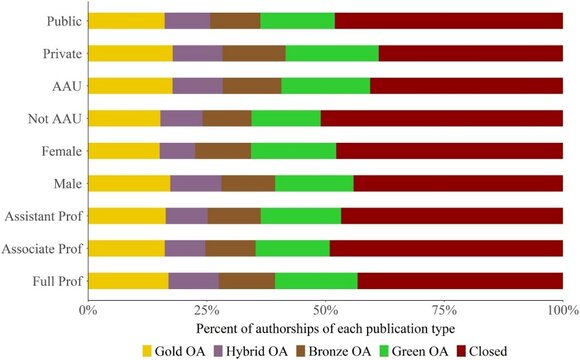
Credit: erhui1979/Getty Images
Equity concerns persist over open-access publishing
Senior male researchers at prestigious institutions are the most likely to pay to publish open access, study suggests.
9 March 2021

erhui1979/Getty Images
The open-access (OA) movement seeks to make research more widely accessible by moving away from the traditional subscription-based model for academic journals. But as many publishers introduce article processing charges (APCs) levied on authors, new equity concerns have arisen over researchers’ ability to afford them.
An analysis of more than 182,000 scholars in the United States has found that the researchers who publish in OA journals with APCs – which can cost several thousand dollars – are more likely to be male, at an advanced career stage, have access to federal funding, and/or be employed by prestigious universities.
The worry, says Anthony Olejniczak, founding director of North Carolina research firm, Academic Analytics Research Center (AARC), who ran the study with Molly J. Wilson, product manager at AARC, is that authors of OA papers may not be representative of the broader research community.
“It’s about who has the money and who has the prestige to make it happen,” says Olejniczak.
The study, published in Quantitative Science Studies, the journal of the International Society for Scientometrics and Informetrics, which is open access, drew on US researcher data from faculty rosters across 11 fields of study in the 2018–2019 academic year.
According to the study, a researcher in the mathematical and physical sciences with federal grant money was 25.3% more likely to have published in a gold or hybrid journal. The results were similar among other STEM subjects, including biological and biomedical sciences (24.9%) and engineering (26.7%).
But this finding is not surprising. Cassidy Sugimoto, a professor of informatics at Indiana University, Bloomington who is also on the Quantitative Science Studies board, points out that the US National Institutes of Health (NIH), a major federal funder, requires scholars to publish OA.
Sugimoto also points to “some fairly strong evidence that NIH is biased in its allocations”. For example, a 2018 PNAS study found that just 31% of NIH grantees in 1991–2015 were women.
Another analysis, yet to be peer-reviewed, concluded that applicants from prestigious universities were 65% more successful, on average, in grant applications.
Open access on the rise
Since the 1990s, there has been a steady growth in OA publishing. A 2019 Learned Publishing Study estimates that 20% of newly released papers are immediately available via open access.
There are different types of OA, and not all come with fees.
-
Gold: All papers are free to read immediately and published under a creative commons license. Some journals have APCs for gold OA, and some don’t. Some publishers offer APC waivers to researchers in low-income countries.
-
Hybrid journals: Subscription-based journals that give authors the option to pay an APC to make their paper gold open access.
-
Green: A version of the article is placed in a repository, usually run by the author’s institution. There are no APCs. Under Green OA, most publishers allow researchers to make their manuscripts OA six to 12 months after the original publication date.
-
Bronze: The publisher chooses to make a paper OA, free to access but with no creative commons license, and retains the right to withdraw that access at any time. There are no APCs.
The strongest predictors for researchers to publish OA are displayed below, including employment at a prestigious institution, defined as those belonging to the Association of American Universities (AAU) an invitation-only group of 63 universities in the US and two in Canada.
 Anthony Olejniczak and Molly J. Wilson
Anthony Olejniczak and Molly J. Wilson
These predictors were even stronger when APCs were in play, say Olejniczak and Wilson.
“Participation in APC open-access publishing appears to be skewed toward scholars with greater access to resources and job security,” they conclude.
An author’s willingness to pay an APC was calculated by combining their gold and hybrid article count. Sugimoto identifies this as a limitation of the study, since not all gold OA journals charge fees.
Olejniczak acknowledges “there is noise in the way we divided things". “But we didn’t want to leave the gold journals that have APCs on the cutting-room floor," he says.
Springer Nature, publisher of Nature Index, announced a deal in October 2020 to offer open-access publishing routes in 34 Nature-branded journals, including Nature.
The cost to institutions that sign up represents a charge of €9,500 (US$11,515) per article, much higher than the less than $6,000 per-article OA fees charged by other journals.
A spokesperson for Springer Nature noted that APCs are funded from a number of sources, including research grants, directly from research funders, from institutions or a combination. The spokesperson said the company offered APC waivers, to enable researchers who cannot fund APCs to publish in fully OA journals.
"Our focus remains on enabling a sustainable transition to OA and we continue to work with our community to address any barriers that limit this transition and their ability to publish OA where they wish to,” the spokesperson said.
(Nature Index is editorially independent of its publisher.)
